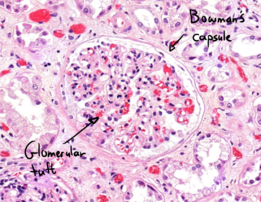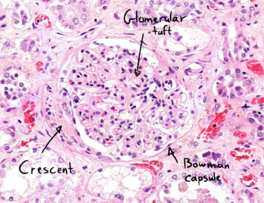10. Rapidly progressive GN with crescents: Difference between revisions
No edit summary |
No edit summary |
||
| Line 1: | Line 1: | ||
[[File:RPGN - overview.png|thumb|Overview| | [[File:RPGN - overview.png|thumb|Overview|262x262px]]'''Staining''': HE | ||
'''Organ''': Kidney | '''Organ''': Kidney | ||
| Line 7: | Line 7: | ||
Almost all glomeruli in the slide contain some degree of fibrocellular tissue. Some glomeruli have this tissue in a half-moon-like formation called ''crescents''. The finding of crescents is associated with RPGN. | Almost all glomeruli in the slide contain some degree of fibrocellular tissue. Some glomeruli have this tissue in a half-moon-like formation called ''crescents''. The finding of crescents is associated with RPGN. | ||
'''Diagnosis''': Rapidly progressing glomerulonephritis (RPGN) | '''Diagnosis''': Rapidly progressing glomerulonephritis (RPGN)[[File:RPGN - glomerulus.png|thumb|(Mostly) normal glomerulus. The glomerular tuft occupies mostly the whole Bowman’s space.|261x261px]]'''Causes''': | ||
'''Causes''': | |||
# Goodpasture syndrome | # Goodpasture syndrome | ||
| Line 17: | Line 15: | ||
## <abbr>IgA</abbr> nephropathy | ## <abbr>IgA</abbr> nephropathy | ||
# Pauci-immune | # Pauci-immune | ||
'''Theory''': | |||
Rapidly progressing glomerulonephritis causes rapid renal failure within days. Diagnosis is based on histology. | Crescents are formed by proliferation of parietal cells and by migration of macrophages into the Bowman’s space. They are comprised of macrophages, fibroblasts, fibrosis and possibly necrosis.[[File:RPGN - glomerulus3.png|thumb|A third glomerulus|264x264px]]Rapidly progressing glomerulonephritis causes rapid renal failure within days. Diagnosis is based on histology. | ||
[[File:RPGN - glomerulus2.png|thumb|Another glomerulus| | [[File:RPGN - glomerulus2.png|thumb|Another glomerulus|none|263x263px]] | ||
[[Category:Pathology 2 - Histopathology slides]] | [[Category:Pathology 2 - Histopathology slides]] | ||
Revision as of 13:31, 7 July 2024

Staining: HE
Organ: Kidney
Description:
Almost all glomeruli in the slide contain some degree of fibrocellular tissue. Some glomeruli have this tissue in a half-moon-like formation called crescents. The finding of crescents is associated with RPGN.
Diagnosis: Rapidly progressing glomerulonephritis (RPGN)

Causes:
- Goodpasture syndrome
- Immune complex mediated
- SLE
- Rheumatic fever
- IgA nephropathy
- Pauci-immune
Theory:
Crescents are formed by proliferation of parietal cells and by migration of macrophages into the Bowman’s space. They are comprised of macrophages, fibroblasts, fibrosis and possibly necrosis.

Rapidly progressing glomerulonephritis causes rapid renal failure within days. Diagnosis is based on histology.

